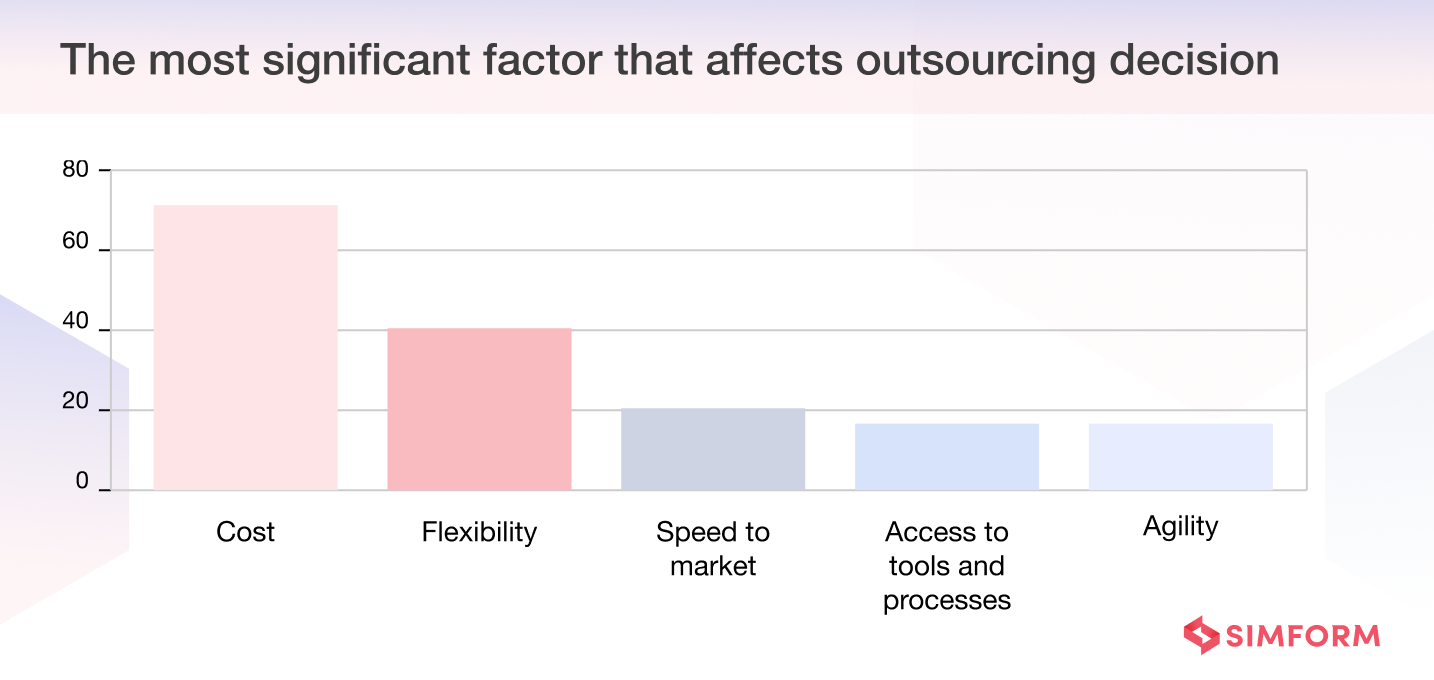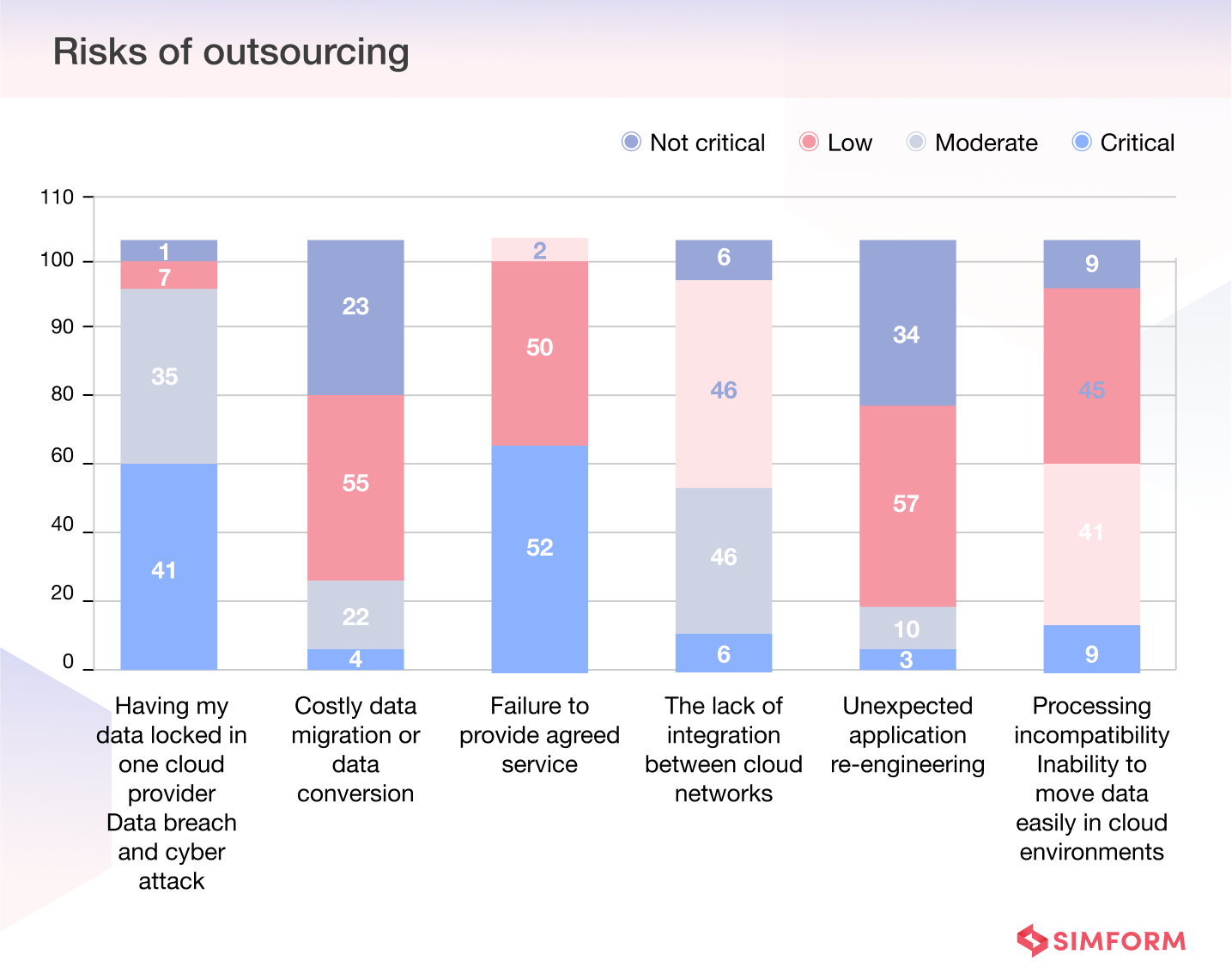Software development outsourcing is a silver bullet for many, but it has challenges if you don’t have a strategy. Take an example of Queensland Health. The public sector healthcare organization partnered with IBM Australia to digitize and improve the payroll system.
However, payroll software failed due to a lack of outsourcing strategy and project management issues. IBM Australia wanted to develop an efficient payroll system to manage more than 24,000 diverse combinations of wage payments. However, insufficient time for planning and software testing services led to payroll software failure on the launch day.
Strategy in any business activity is key to success. Software development outsourcing is no different as it sets the foundation for overcoming challenges, performance bottlenecks, and cost optimization.
Here, we will discuss everything about software development outsourcing, from what it is to its benefits, reasons to outsource, and more. So, let’s begin with what outsourcing is!
What is software development outsourcing?
Software development outsourcing essentially means taking the help of an able company or technology partner that develops the software on your behalf according to your requirements. Usually, you hire dedicated developers or an outsourcing team from a company with the relevant experience, knowledge, and skill to deliver quality software.
Software development outsourcing will become a $1.06 trillion industry by 2030. Also, global IT services spending is estimated to cross $1.389 billion by the end of 2023. These numbers speak volumes of the pervasiveness of software outsourcing and how it is being leveraged by businesses in every industry vertical.
Based on the goals of your business, its industry, the available resources, and many more factors, you can benefit from software outsourcing using one of the various existing models. Let’s have a quick look at outsourcing models in the next section.
Software development outsourcing models
There are many types of software development outsourcing models. You can choose an outsourcing model to delegate projects based on the scope, size, location, complexity, and project budget.
Nearshore outsourcing
In the nearshore software outsourcing model, you outsource software development efforts to a company in a nearby country or the same country. For example, a company in the US outsources software development to another business in Canada or Mexico.
Offshore outsourcing
The offshore outsourcing model is where you outsource the software development to a service provider in foreign countries or outside your home country. One of the most significant reasons for offshore outsourcing is cost reduction. According to Deloitte, cost is one of the most critical factors for organizations to opt for an offshore team.

Offshore outsourcing to a service provider from other countries offers cost benefits as you can have skilled professionals at a lower price than domestic talent. For example, the salary of a software developer in the US is $93,858 per year, while it is $63,832 in Germany.
Onshore outsourcing
The onshore model involves outsourcing development and testing activities to external service providers in the same vicinity. It allows businesses to leverage local companies for the software development process. Further onshoring enables organizations to outsource non-essential or essential tasks to focus on the core business activities.
| Nearshore Outsourcing | Offshore Outsourcing | Onshore Outsourcing | |
| Time Zone difference | Lower | Higher | Lower |
| Visibility | Higher | Lower | Higher |
| Collaborations | Better | Less cohesive | Better |
| Controls of project | Higher | Lower | Higher |
| Time-to-market | Moderate | Lower | Moderate |
Why choose software development outsourcing?
Outsourcing is a decision that needs a thorough requirement analysis. In other words, you need to know exactly why to outsource software development.
You want a software developed with a specific budget!
If you have a specific budget for software development, outsourcing is an ideal choice-” WHY?” According to a report, 82% of businesses fail due to cash flow problems, and 27% fail due to lack of capital.

So, being mindful of your budget while you develop software is essential.
Outsourcing software development can help you reduce hiring developers, internal resources, and recruitment costs. Imagine the time, effort, and cost of hiring a remote development team! Outsourcing reduces recruitment costs and provides access to top IT talents.
For example, if you need React on the frontend and have a small team for backend, you can choose to outsource software development. The cost of hiring an in-house React developer involves recruitment, onboarding, insurance, and other expenses. Outsourcing the frontend development, which may need more than one developer, can help you reduce costs.
You are developing complex software with lots of features!
Building an engineering team is massive if you develop complex software with multiple features using different technologies. Outsourcing software development can help you focus on core business logic without the hassle of creating an in-house team.
Finding heterogenous talents and recruiting and training them can take more time and investment in training modules and collaborations. On the other hand, outsourced teams remove all the hassle of in-house teams to offer higher flexibility and scalability.

In other words, you can add or remove developers based on your requirements in an outsourced project-based model. So if you need to add features with integration of Artificial Intelligence, Machine Learning, or Natural Language Processing(NLP), you don’t need to spend on hiring them individually!
You are on a deadline to complete the project!
The timing of your product launch can make or break your business. However, rushing your software development can lead to performance issues. Outsourcing your software development to a company with a massive pool of industry-ready resources ensures the timely completion of your project without compromising on quality.

If you plan to develop it in-house, the time needed for hiring, training, planning, designing, development, and testing will be higher.
You want to reduce the project risks!
Software development projects need proper testing, monitoring, and tracking to reduce errors. However, software bugs are not the only risks that you need to worry about! Software security failures are also a significant concern.

Fortunately, software development outsourcing can reduce the risks of bugs and security failures and provide high availability. In addition, outsourcing helps you access top software development experts to mitigate risks.
Further, outsourcing the development enables you to leverage testing expertise making sure there are no errors.
Lastly, outsourcing helps you with on-demand support round the clock and accommodates changes rapidly to improve the agility of the business. Though, like all approaches, outsourcing is not a perfect solution, with risks involved.
You want to access the best tech talent available worldwide!
When you decide to outsource a project, its development is no longer restricted by geographical location. For example, you can choose developers from the US, the UK, Asia, Australia, or any other region. The primary criteria for hiring the right professionals include their skills, experience, and knowledge. If you are opting for a software development company, you can view the company’s portfolio, read customer reviews, analyze custom retention rates, and ask the company about the successful products they’ve built over the years. These aspects will help you find the best tech talent available in the global market.
Hiring exceptional talent means you don’t have to compromise on the quality of your product. Also, all remote tech team members will bring diverse perspectives on various facets of the project. And so, building a team from a global talent pool allows you to embrace diversity, break cultural barriers and drive innovations.
You want the best price-quality match!
When you consider outsourcing, the first advantage that comes to your mind is the optimum budget, which is true. However, outsourcing is not limited to monetary benefits. It also allows you to find the best possible talent that can provide you with high-quality solutions at an affordable rate. Software development outsourcing can help you strike a balance between price and quality. Depending on the location, you can tailor your budget and find the best available human resources accordingly.
For example, some developing countries have risen in software outsourcing ranks in the last few years. You can tap into the talent pool of these countries that is available for hire at a reasonable rate. Compared to that, hiring professionals with the same skills from developed countries like the USA is much more expensive. Ultimately, it’s about finding the right balance between price and quality.
You want to build a cross-functional team faster!
If you are considering building the software in-house, you also have to build an in-house cross-functional development team. Finding experts in various fields in one geographic area is difficult. However, if you outsource the software development project, you get access to experts with different specializations and get them to work together on your project. For example, you can hire UI/UX designers and business analysts from one place, expert developers and testers from another, and strategic consultants from a third place.
If you don’t want to do that, you can find a reliable software development company that fits your budget and aligns with your business needs. They will come on board with outsourcing experience and a dedicated cross-functional team comprising business analysts, solution architects, UI/UX designers, software programmers, QA engineers, and marketers. It will help you develop the software faster to lower the time-to-market and gain a competitive advantage.
You don’t want to micromanage all the things!
When you outsource your software development project to an agency or organization, they assign a dedicated project manager who handles day-to-day tasks. The project manager (PM) brings the dedicated development team and the product owner to the same page about expected outcomes and timelines. After you approve the project plan and estimate, the PM takes care of the entire execution process.
As a product owner, you’re free from micromanaging every little aspect of your project. You can focus on other important business-related tasks while project managers plan the sprints, set the deadlines, control the delivery, schedule, and prepare feature demos. You can always ask for the project status regularly and provide your feedback. The project manager will respond to your feedback, and you will get all the required information without investing time in checking the status of tasks every now and then.
Despite these benefits, outsourcing software development is not a perfect solution and involves certain risks. Let’s look at the major risks of software development outsourcing and how to mitigate them in the next section.
Risks of outsourcing your software development
Outsourcing the development of your software is not a silver bullet! In other words, there can be problems if you don’t have a strategy for outsourcing the development process. So, here are some risks of outsourcing without a strategy.
Risk of low-quality products and delayed delivery
Outsourcing can be risky, especially when you need to deliver software on time! Because without the right outsourcing vendor, project completion can be delayed.
Many vendors promise to deliver the product on time, but lack of management may lead to problems and delays. Yes, some of the vendors deliver on time; however, their quality needs to be up to the mark.
Take the example of Target. It is one of the grocery chains in the US and had an ambitious project to enter the Canadian market. They hired Accenture consultants to build a unique SAP system for their stores across Canada.
However, the SAP system failed to deliver accurate data leading to massive inventory issues. As a result, the target had to leave Canada, closing more than 130 stores. One of the critical reasons for SAP system failure was overwhelming data and project management issues.
Similarly, you need to test the software enough before going for the launch.
Security risks involved with outsourcing software development
Outsourcing software development means you have to share data with a vendor. So, if you don’t have the right data access and security policy, it can lead to information leakage. According to a report, 43% of all cyber threats are internal, whether they are intentional or unintentional. So it becomes crucial to secure access to your internal data and network.
So, how do you secure your data when outsourcing?
The best way to avoid such a scenario is to have a Role-based access control (RBAC) policy. It is an approach where information access is restricted to specific roles. So, an employee or outsourcing vendor can access the data that is required.
Lack of control
The type of outsourcing you choose to control software project management can vary. For example, you can have better control with onshore or nearshore projects and less with offshore outsourcing.
However, control is not an issue if you outsource with a vendor with higher transparency in communicating different stages of software development. So, it is vital to select the right outsourcing vendor. One way to improve control and quality of software delivery is to choose an extended team.
Vendor lock-in
Vendor lock-in is a significant risk of outsourcing because you may end up paying more and yet be restricted to a specific tech stack. It might also be a massive problem when you are developing cloud-based software. For example, if your vendor offers AWS services for cloud-based software development, the tech stack will be restricted to specific tools and technologies.

According to research, being locked into a single cloud service provider is a significant risk. The study was focused on UK businesses indicating how vendor lock-in is a massive barrier to cloud adoption. Respondents reported significant challenges of
- Moving data/applications out of cloud environments
- Data ownership problems
- Cyberattacks and data security concerns,
- Lack of interoperability with third-party service provider.
The best way to avoid third-party vendor lock-ins is to find a custom software development company that provides higher flexibility in tech stack and cloud migrations.
An outstanding outsourcing strategy, explicitly designed for your business needs, is an answer to all the challenges that we just discussed.
Software development outsourcing Strategy
Before creating a strategy for software outsourcing, you should first have a transaction value analysis, an inter-organizational process measuring the collaboration with vendors or offshore companies based on factors like
- Cost
- Shared responsibility
- Risks
- Control
- Transparency
Such analysis helps you understand the value drawn from outsourcing. Transactional value can help you formulate a robust strategy.
First, define the project goals.
Defining the goals needs the right questions asked. For example, one critical question will be, “Why outsource software development?”
Similarly, other questions you need to ask to define the project goals are,
- What is the outcome you are trying to achieve with your project?
- How will outsourcing help achieve that outcome?
- What is the tech stack needed to develop your software?
- Does your outsourcing vendor provide the required tech stack and talents?
- What are the metrics to measure project outcomes?
- What is the timeframe and budget of the project?
Once you have defined the goals, it’s time to estimate the project’s total budget- but why?
A significant reason why organizations choose to outsource is the cost, and so estimation is essential.
Next, estimate the project’s budget!
The internal processes for estimation involve predicting the costs and expenses of software development. Here are three techniques to estimate the software development budget,
- Empirical estimation technique is a method of estimating the software development budget based on data aggregated from previous projects.
- Heuristic technique is based on the Constructive Cost Model (COCOMO) and uses a regression formula with industrial data for estimation.
- Analytical estimation technique estimates the budget through tasks divided into simple operations and timelines for each measured.
Now that you have a budget ready, it’s time to,
Identify the skill gap
Skill gap assessment allows for the formulation of an outsourcing strategy. But first, you need to identify the tech stack required for software development. Once you have the tech stack decided, finding the skills required to use it is the next step.
Once you identify the skills needed for your project, finding a software development partner offering a similar skill set is crucial to achieving the goals.
Ensure proper communication and transparency
Communication with your outsourcing vendor and transparency of the project’s progress helps you with higher visibility. It also enables better project management and tracking of vital metrics.
Collaboration should be essentially strategized, especially for offshore outsourcing, as there will be time and zone differences. For example, you are an organization in the US and outsourcing your project to a company in Australia. There will be a difference of 14 hours which acts as a barrier.
So, you need to look at tools like slack, skype, zoom, and others to improve collaborations. These tools provide file sharing and real-time chat features, which helps in better collaborations.
Understand the software development methodology
Software development methodology plays a crucial role in the execution of the project. For example, agile software development follows an incremental process with continuous feedback integration. In contrast, the waterfall development approach follows a sequence of stages where a new stage begins only after the completion of the predecessor phase.
Choosing between waterfall vs. agile development needs a thorough assessment of project goals, size, complexity, and timeline. So, if you want rapid growth, agile is the best approach, as there are no delays and quality is high due to continuous testing.
In other words, your outsourcing strategy should include which methodology to use for software development. Similarly, your outsourcing vendor’s software development methodology should align with yours.
Select the suitable engagement model
Outsourcing companies provide flexible engagement models, but your selection generally depends on your project needs, timeline, and budget.
- Time and material model is an approach where you are charged based on the total time a developer spends and the infrastructure used. The charge on the developer’s time can be on an hourly basis.
- Fixed price model is where everything from project requirements, budget, and timeframe is agreed upon before the commencement of software development. It does not allow flexibility in sudden changes and has a fixed price agreed upon by both parties.
- Dedicated team model is where experts from the outsourcing vendor’s pool of experts work become a part of your work culture. In other words, it is an extension of your existing team with a developer’s fee charged hourly.
Software development outsourcing costs[Factors to consider]
Software outsourcing cost is a significant aspect in deciding whether to outsource the project or not. Some factors that can affect outsourcing costs are the type of the project, size, and vendor location. However, estimating the software outsourcing cost can get tricky due to the heterogeneity of each project, as what works for one project may not work for another.
Type of project
Software development projects include frontend, backend, full stack, web-based, desktop, and mobile application development.
- Frontend development – highly-skilled developers create functional and visually enhanced user interfaces.
- Backend development – individual developers focus on the parts invisible to users. It involves building an infrastructure focusing on functionality, system integration, and execution of business logic.
- Full-stack development – includes both frontend and backend development
- Desktop development – creating applications that run on Windows, macOS, Linux, and other operating systems.
- Web-based development – web apps are created by web developers for users to access the software through the internet.
| Type of software development | Average salary of developer per year |
| Frontend development | $96,561 |
| Backend development | $95,924 |
| Full-stack development | $115,127 |
| Desktop development | $124,639 |
| Web-based development | $84,603 |
Size of the project
The size of your software project is key to outsourcing cost estimations. For example, large-scale projects need more resources and time, while small-size projects need fewer resources. Also, the project’s size is a significant factor, especially for the time and material engagement model.
Location of the vendor
The location of the outsourcing vendor is crucial for estimating software development costs as they are different for each region.
Here are some hourly rates of the frontend developers in different countries.
| Location | Frontend developer’s median salary per year |
| United States | $92,939 |
| United Kingdom | $56,561 |
| Germany | $55,192 |
| Australia | $126,817 |
| India | $8,622 |
As you can see, hiring a frontend developer from India is cheaper than Australia and the United States. Similarly, backend and full stack remote developers have different hourly rates per the vendor’s location.
Case studies of software development outsourcing
Discussing a case study for software development outsourcing is key to understanding what went right for organizations and what we can learn from it.
Unilever outsourced ERP integration
Unilever is a massive consumer goods company with establishing businesses requiring more than 200,000 employees needing ERP system integration. However, despite having enough resources to hire an in-house tech team, they chose to outsource the integration. And a significant reason for outsourcing was the lack of core competency in managing ERP integrations across platforms.
Skype outsourced the entire software development
Skype is one of the established companies offering telecommunications, messaging, and conferencing solutions. However, despite being such a massive organization, they chose to outsource entire software development. One of the primary reasons behind it was a lack of necessary expertise in developing the software.
So far, we have seen the various nitty-gritty of software development outsourcing. However, the subject would remain incomplete without exploring outsourcing companies’ software development process. So, let’s explore them in our next section.
Software development process
No matter how simple or complex the software is, you want it to be flexible and easy to maintain. The only way to ensure that is to have a solid understanding of the software development process and the knowledge of best practices to implement at each stage.
Here are the typical phases involved in a software development process:
1. Ideation
Every software development project begins with an idea. To narrow down on the right idea, you need to know the business needs, and the core customer pain points, and determine how to ease those pain points through your software.
The ideation phase comprises the following activities:
- Conducting a feasibility study of the idea via PEST (Political, Economic, Social, and Technological profile), SWOT (Strengths, Weaknesses, Opportunities, and Threats) analysis, and focus group discussion
- Determining the project scope
- Enlisting the details of project ownership, objectives, goals, and deliverables
- Defining various stakeholders
- Developing a business case that helps you translate an idea into a product
2. Planning
The planning phase comprises the following steps:
- Crafting a project plan
- Building a development team
- Identifying the roles and responsibilities of each team member
- Estimating the total budget of the project
- Collecting the required hardware and software resources
- Evaluating risks involved and crafting a risk mitigation plan
- Creating an SRS (Software Requirement Specification) documentation
Having rich documentation of your project is one of the cornerstones to success in any software development project. Also, updating the documentation regularly as the requirements evolve is paramount. You should incorporate whatever is discussed and analyzed during the planning phase in an SRS document. An SRS document provides a roadmap for product development and the resources you will need to accomplish the project.
3. Designing
UI and UX are among the first things users interact with when using your software. Therefore, having an intuitive, easily navigable, and visually appealing design is essential to ensuring a satisfactory customer experience.
The design phase in the software development process comprises the following considerations:
- Architecture: Overall skeleton of the product
- User Interface (UI): The way the user interacts with the product
- Platform-Specific Guidelines: Android, iOS, or Windows-specific design guidelines
- Communication: The way a product communicates with other assets
- Security: Measures to prevent data leaks, including SSL encryption, password protection, 2FA, etc.
At the end of the design phase, you’ll have a prototype ready, a visual representation of your product’s first appearance.
4. Coding
The coding or development phase is the backbone of any software development process. Here, your team translates planning and design into an actual product. If you’re building a small business project, a single or a few developers with significant coding expertise can handle the task.
However, the tasks have to be divided amongst a bigger team based on specific expertise if you’re working on a large-scale project. For example, a front-end developer will focus on building a robust UI and communication gateway with the server, a database administrator will work on database design, and a back-end developer will connect the front-end and back-end of an application into one cohesive system.
Make sure that the code developed during this phase aligns with the initial project requirements. The development phase will take the most time, but if other teams have arrived at appropriate outcomes during the planning and designing stages, you won’t have to face too many challenges. At the end of this phase, you will have a working product with a source code repository.
5. Testing
After finishing the development phase, it’s time for the QA team to conduct quality assurance by analyzing the source code and checking if there are any bugs, errors, or security gaps. At this point, the product goes through rigorous testing of various types such as functional, performance, regression, unit, integration, security, usability, black box, white box, etc.
Once all the errors have been identified through an established quality assurance process, QA passes the detailed report to the development team. The development team works on the errors or bugs and sends them back to the QA team for re-testing. This process is iterative and goes on until the product is declared bug-free.
6. Deployment and maintenance
After the testing phase, you launch the product to a small user base that is also your target audience, and the support team starts gathering feedback from the early users. You then analyze the feedback, incorporate the suggestions in your product, and finally launch it in the market! However, the cycle doesn’t end here. You must aim for continuous improvement of the product to stay relevant and avoid saturation. So software maintenance is also an integral task that your team must regularly perform to ensure the optimum quality and performance of the product.
Conclusion
More than a decision, software outsourcing is a business transformation. If you get it right, results are great, but everything you invested in may go haywire if it goes wrong. So, consideration of all the risks, outsourcing models, costs, and project requirements becomes important.
However, choosing an extended team model can be worth your investment as it provides flexibility and reliability. Simform is at the forefront of providing software engineering with a dedicated team acting as an extension of your organization. So, signup for a 30-minute free session with our experts now!
Here are some tips to help you choose the right software development vendor for your business:
1. Determine their expertise by looking at their portfolio or case studies.
2. Identify the technologies they work with and shortlist the vendors that are experts in the tech stack your project requires.
3. Look for well-established development and communication processes.
4. Analyze if they’ve done any projects relevant to your industry verticals.
5. Check whether they are ready to sign a Non-Disclosure Agreement or intellectual property rights agreement as per your expectations.
6. Contact their previous clientele from Clutch or GoodFirms profile and how they have rated the vendors’ services.
7. Reviews and ratings of the vendors on various platforms also help shortlist reliable partners.
There is no one-size-fits-all approach to finding the right software development outsourcing company. It all boils down to individual business needs, budgets, and the complexity of the software that the owner wants to develop.
Generally, the technology partner will assign a dedicated project manager if you outsource your software development project. The project manager will handle daily operations and act as a bridge between the new technology partner and the product owner.
As a product owner, you don’t need to micromanage daily activities. However, if you have any essential inputs or concerns, you can covey those to the project manager. The project manager will stay in touch with you throughout the project management process and make sure the deliverables at every step match your expectations.